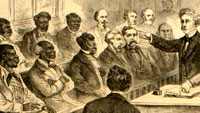Lincoln and Black Abolitionists
Manisha Sinha of the University of Massachusetts, Amherst, looks at the influence of black abolitionists on the policies and views of Abraham Lincoln, and the evolution of Lincoln's views on slavery and emancipation.
Manisha Sinha of the University of Massachusetts, Amherst, looks at the influence of black abolitionists on the policies and views of Abraham Lincoln, and the evolution of Lincoln's views on slavery and emancipation.
According to the Gilder Lehrman website, "Henry L. Luce Professor of the Civil War Era and Professor of History at Gettysburg College Allen Guelzo examines Abraham Lincoln's motivations for issuing the Emancipation Proclamation in January of 1863. Guelzo contends that the proclamation is among the most misunderstood of the Civil War era, a necessary and even desperate attempt by Lincoln to enact a form of emancipation that would pass legal muster. Guelzo traces the evolution of Lincoln's views on emancipation with particular emphasis on the strategic and moral calculus that factored into the momentous proclamation of 1863."

The After Slavery Project, a transatlantic research collaboration directed from Queen's University Belfast, launched its Online Classroom, a set of 10 online units that explore the aftermath of emancipation in the Carolinas. Organized thematically, the teaching units cover a range of topics, richly illustrated with an array of primary source materials from dozens of archival collections.
The unit Freed Slaves Mobilize, for example, includes a background essay, transcriptions of nine primary source documents and illustrations, questions related to each document, and suggestions for further reading.
After Slavery addresses emancipation both as an attempt by African Americans to overcome the racial legacies that attended and outlived slavery and as a profoundly important chapter in the history of America's working people. One aspect of this story that has become clearer in recent years is the variety of experience among former slaves across the South. These variations make it necessary to move away from broad generalizations about 'the' African American experience after the Civil War and to try to uncover both the shared elements in black life across the region and the varying capacity of freedpeople to mobilize. This emphasis on the "multiple configurations of freedom" across the post-emancipation South provides the rationale for the project's focus on North and South Carolina: together these states reflect the productive, demographic, political, and geographic diversity of the region as a whole.
EDSITEment posts new materials this month from 19th-century historical writing to material culture to fiction. New resources include a feature on teaching Alexis de Tocqueville's Introduction to Democracy in America, and new lessons on Thomas Hart Benton's painting The Sources of Country Music, and Ernest Hemingway's short story Three Shots.

From Slavery to Freedom: The African-American Pamphlet Collection, 1822-1909 is precisely what it says, a collection of 396 pamphlets written by African Americans or by non-African Americans writing about slavery, Reconstruction, the colonization of Africa, and other pertinent topics.
According to the website, "[. . . t]he materials range from personal accounts and public orations to organizational reports and legislative speeches." Prominent authors include, but are certainly not limited to, Frederick Douglass and Booker T. Washington.
Material can be browsed by title, author, or subject; or you can run a key word search. If you need more material than what is available in the collection itself, there is a list of external resources with related content.

Yale University has made a sampling of their courses available for listeners, viewers, and readers.
As of writing, the history subsection contains six courses—two of which relate directly to U.S. history ("The American Revolution" and "The Civil War and Reconstruction Era, 1845-1877") and one which touches on relevant issues, "Epidemics and Western Society Since 1600." Each of these courses offers links to individual pages for each lecture. Lecture pages contain short text overviews of the topic at hand; a list of any reading which was required for the day; and links to lecture audio, video, and transcriptions.
Our site links you directly to the Yale's history courses. However, consider exploring other topics as well. Maybe a lecture on Roman architecture will give you background for discussing monuments in Washington, DC, or an economics course will give you a new way of thinking about the American Revolution. Interdisciplinary possibilities are endless.
Loren Schweninger of the University of North Carolina at Greensboro describes the relationship between Abraham Lincoln and Frederick Douglass, including their meeting in the White House following Lincoln's inaugural address.
John David Smith of the University of North Carolina at Charlotte considers Abraham Lincoln's reasons for allowing black troops to fight in the Civil War and for issuing the Emancipation Proclamation.
Professor Allen C. Guelzo traces Abraham Lincoln's views and political decisions regarding slavery, leading finally up to the Emancipation Proclamation. He questions and explores the text and Lincoln's possible intentions in writing it, looking at the context within which it was written. Guelzo also focuses on changing perceptions of the Proclamation, from admiration to criticism, and looks at why this change occurred. This lecture continues from the lecture "The Emancipation Moment: Abraham Lincoln and the First of January, 1863, Part One."
Professor Allen C. Guelzo traces Abraham Lincoln's views and political decisions regarding slavery, leading finally up to the Emancipation Proclamation. He questions and explores the text and Lincoln's possible intentions in writing it, looking at the context within which it was written.
Professor Lucas E. Morel examines the life and views of abolitionist Frederick Douglass, especially his views of the U.S. Constitution and of the condition of African Americans and the fight for civil rights both before and after the Civil War, as revealed in his writings and speeches. This lecture continues from the lecture "Frederick Douglass, Part One."
To listen to this lecture, scroll to the Monday, August 2nd, 4:30 pm-6:00 pm session; and select either the RealAudio image or link in the gray bar to the left of the main body of text.
An older version of this lecture can be found here.